Driving around with three snipers in the back of your jeep is overkill. But the shiny soldier boy of the Halo games has never cared less. This is the prime indulgence of Halo Infinite, the latest of the venerable sci-fi shootybangs. Sweet moments where it’s just you, an open country of undulating hillsides, and a truck full of trigger-happy marines. The developers have taken the eponymous second level of the first Halo, in which the big tin fella had to drive about helping his marooned space crew, and they’ve used it as a mood board for an entire game. Aside from a few gripes, it has worked splendidly.
If your previous Halo visits are patchy, you may have a hard time understanding what’s going on. Master Chief’s ship is attacked by a faction of alien misfits called the Banished, and he is promptly thrown into space. He wakes up above a new Halo ring with two new friends. A pilot who has spent the last six months alone, and an AI who is basically Cortana formatted to factory settings. They land on the ringworld and get to scrappin’. The plot that follows isn’t as thick ‘n’ fast as previous games, but it still doesn’t spare the backstory, with many flashbacks and throwbacks from previous Halos. Anyone expecting a self-contained adventure won’t be entirely satisfied. It is both a love letter to past instalments and the continuation of a convoluted sci-fi saga, adding more loose ends (and a traditional anti-climax) to a series that already has its fair share.
On the plus side, it has lightened up a lot. When the pilot asks Master Chief if he can hack an irksome alien computer, the supersoldier simply punches it and replies “no”. I’m not so blinkered a fan as to believe the big fella’s habit of one-word responses hides a deep well of meaning. But it at least functions as a good laugh. Likewise enemy grunts bark a medley of delightful cowardice and misplaced bravado. “Come out little man!” they yell. “You’ve got a gun, I’ve got a gun! What are the odds!”
Some of the humour doesn’t land, however, and dialogue is laced with now-ubiquitous Marvel-flavoured quips. Some of it skews perilously wacky. In the open world there are propaganda towers broadcasting grunty declarations of superiority, using contemporary human idioms like “key takeaways” or “hear me out” amid the folksy cussing of “friggin” or “heck no!” That incongruous human style invites the kind of inspection that “meat is back on the menu” does for Lord of the Rings (although one grunt audio diary I’ve just come across uses this exact phrase, so you’ve got to assume the writers know, and just don’t care). Ultimately, I’ve decided gruntcasts are OK. I’d rather a game go for funny and suffer some crickets, or misstep into incongruity, than rely on the dour-faced jargon Halo games have often been guilty of. Also, most players won’t overthink things this much.
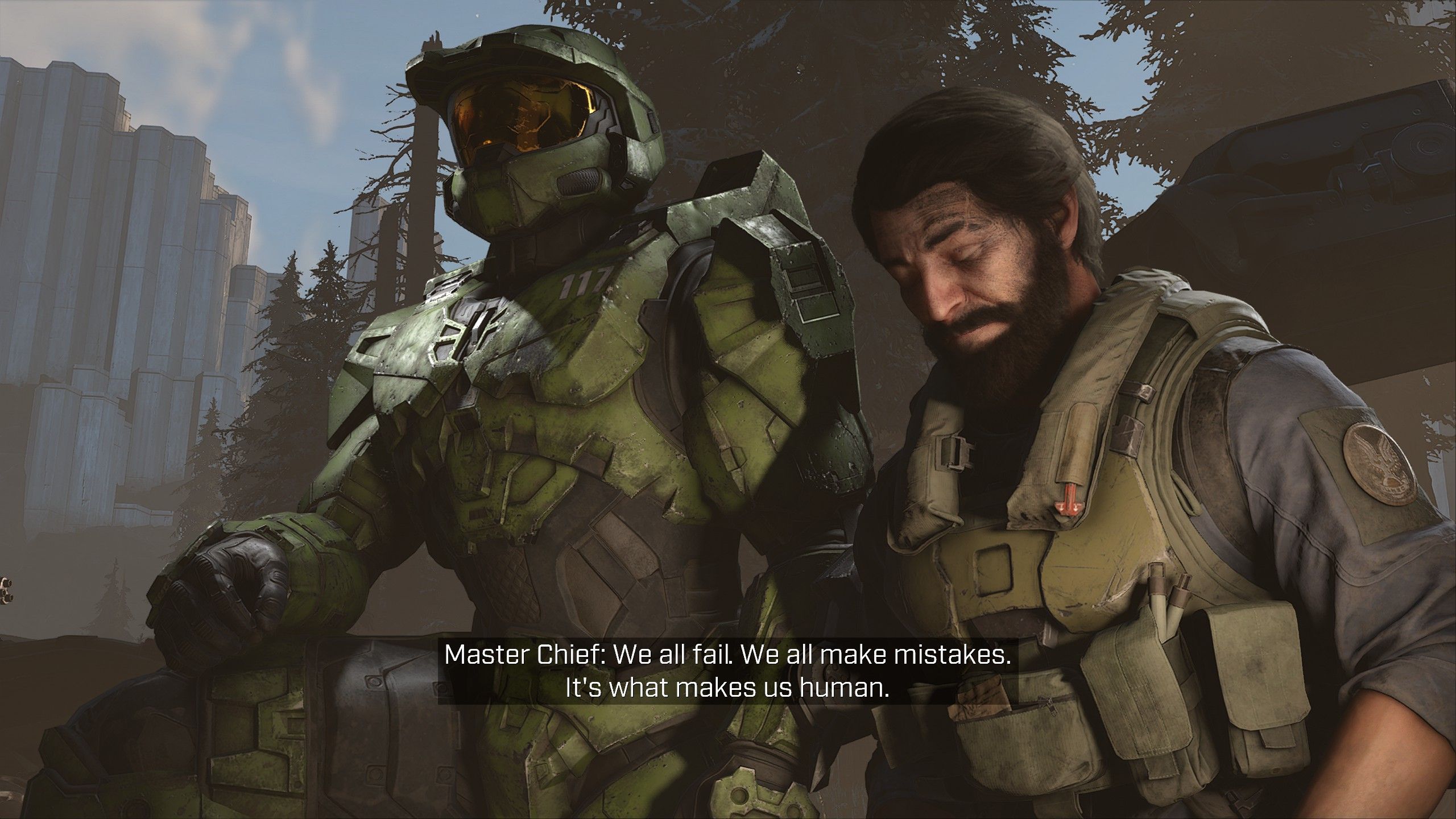
The propaganda towers aren’t just decorative. Destroying them is one of the handful of open world tasks you can eventually perform. The first couple of missions are linear shootouts through Banished ship corridors and subterranean Forerunner atriums that will soothe the hexaholic architecture fans out there. But soon the horizon is revealed, and you are faced with a map bigger than any Halo that has come before. Not Grand Theft Auto big. But sweeping enough for our purpose, which is to insert bullets into extraterrestrial noggins.
There are marines to save, outposts to set ablaze, and VIP enemies to kill across a mix of Warthoggable landscapes and precipitous rockfalls as a day and night cycle keeps things pretty. You can see your jobs on a map screen pimpled with icons. Some might lament the Ubification of a once traditional shooter. But the map is relatively clean, the busywork limited to a handful of side hustles. There are no animals to skin, no flowers to harvest, no towers to climb. Basically every icon involves a different flavour of bullet sauce on the vanilla shooting. The ring is a rolling, bumpy landscape, great fun to tear across in a hog full of marines. You get a grappling hook that makes it quickly traversable on foot, with lots of cliffside shortcuts and hijackable vehicles. Trekking from A to B feels good however it’s done. In the 20 or so hours I spent ambling through the campaign, I used fast travel exactly once.
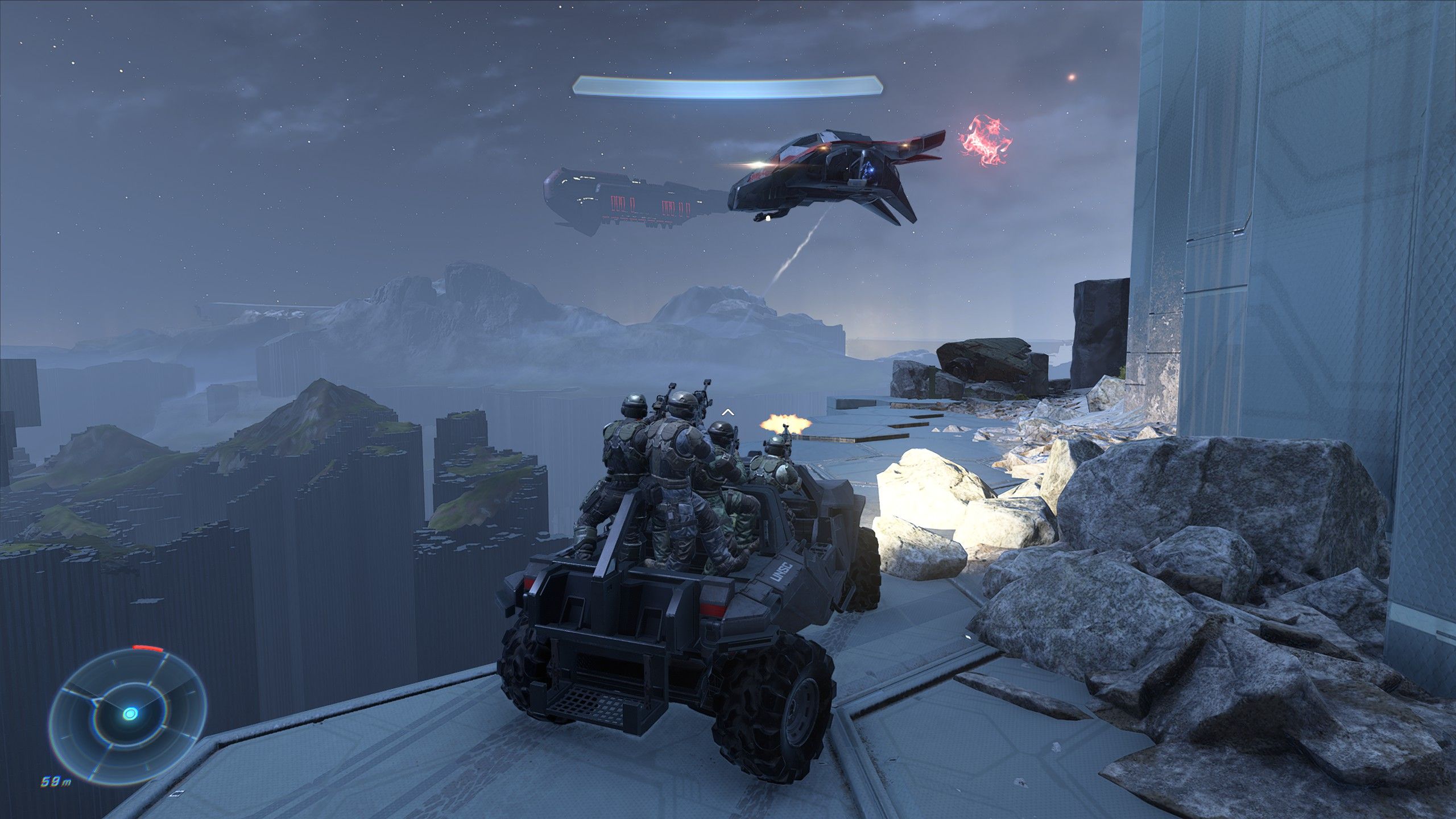
Another star is the high-spec Riven Mangler, which fires three slugs at once and kicks so hard it is like using God’s revolver.
There are also small human garrisons to recapture. These forward operating bases, once retaken from a few Banished bad dudes, let you call up guns and vehicles on the spot. They also become more populated with marines the more you perform your saviour duties. The other big task is to kill high-profile aliens, which rewards you with special weapon variations. An energetic grenade launcher with extra bounciness, for instance, or a disruptor pistol that can EMP vehicles in one hit. Once you unlock these, you can summon them from the gun stations at any FOB you’ve captured. Eventually you build a small arsenal of gravity hammers, harpoon launchers, needlers and shock rifles.
Human weaponry and vehicles are unlocked by accruing Valor, a tally of hero-points increased with each side job. Destroying a propaganda tower will earn you 10 points of valor, for example. Freeing some marines will get you 30. Eventually you’ll be able to summon rocket launchers, specialist battle rifles, a Scorpion tank. I spent most of my time in the Razorback Warthog, a six-seater rumbletruck that you can pack with sniper-toting allies, then take them doughnutting around adversaries with hit-and-run glee. Another star is the high-spec Riven Mangler, which fires three slugs at once and kicks so hard it is like using God’s revolver.
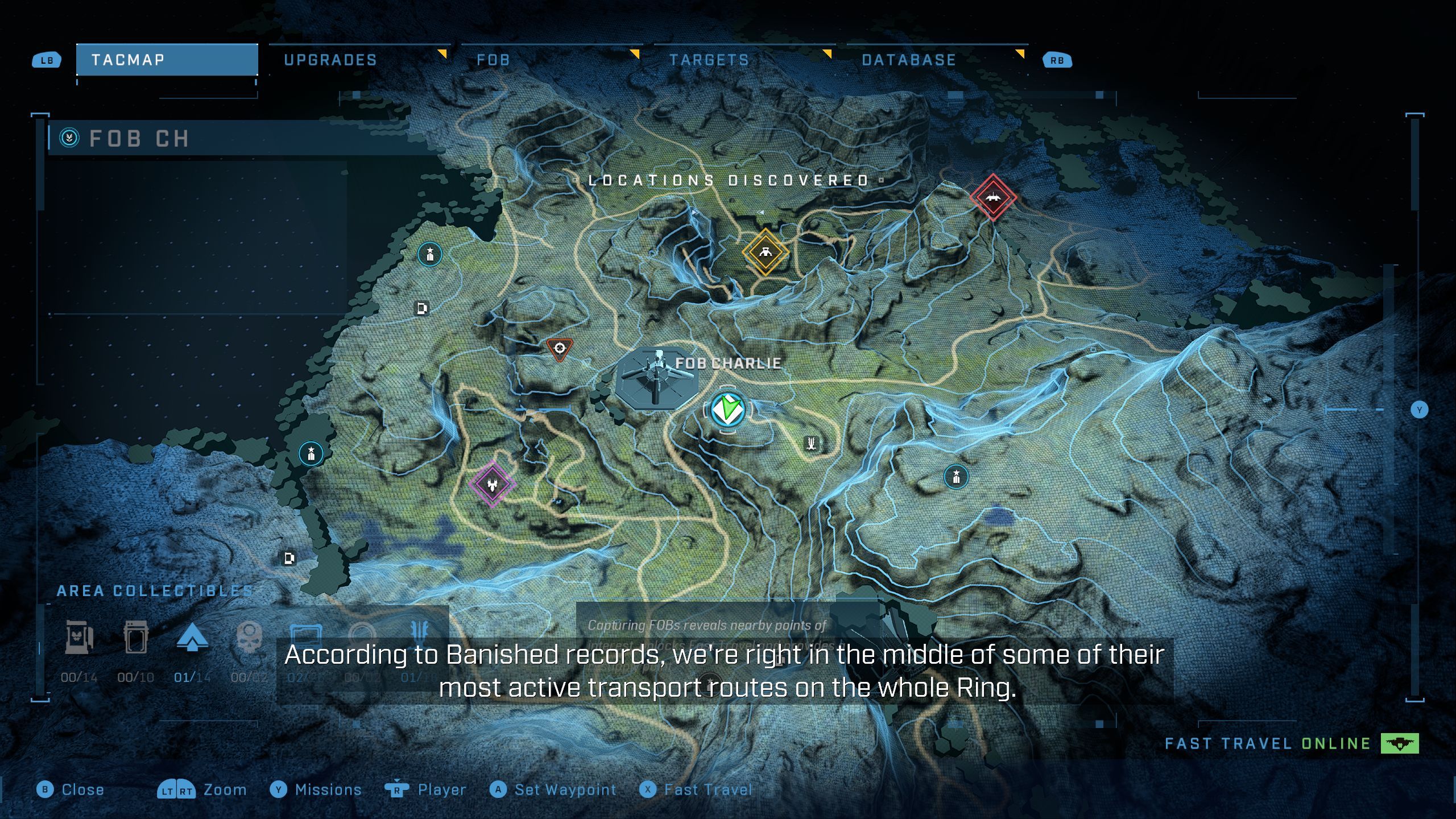
There are smaller tasks. Metal cases are scattered around containing upgrade do-hickeys for your grappling hook, shield, and other equipment. Or you can find armour lockers, which contain cosmetics to use in multiplayer. (I wasn’t able to inspect these armour pieces in the review build, so I don’t know what they look like or how much they’ll take the edge off the battle pass woes of the free-to-play multiplayer. But they might).
These collectibles, combined with the reach of the grappling hook, encourage a kind of exploration and egg hunting I didn’t realise I missed from Halos 1 and 2. You’ll come across snoozing grunts, secret doorways, dimly lit caverns. It summons nostalgia for the days when I’d scour every inch of New Mombasa for skulls, or exploding spaceships for pacifist grunts with a keen thirst. Infinite captures some of that magic. It’s something open world games have understood for a long time: fill your nooks and crannies. It’s just affirming to see these lessons applied to a Halo game.
The upgrade tree is magnanimous. Nothing costs more than three upgrade-o-chunks. You can fully upgrade your shield to be stronger, or your grappling hook to be an electrifying slammer, in a fairly short time. There are other pieces of equipment, such as the movement sensor, a shootable beacon that reveals enemies through walls. Which is handy when fighting enemies draped in optic camouflage. Or a drop shield which acts as a translucent film of cover you can shoot through worry-free. But the grappling hook far outweighs these in terms of usefulness, so it’s the one you’ll upgrade if you’re smart. It changes up the Halo fight-waltz significantly, letting you pick up tossable canisters of pain or escape fire in a pinch. I rarely used the other abilities outside of circumstances where it felt the game was heavily encouraging their use.
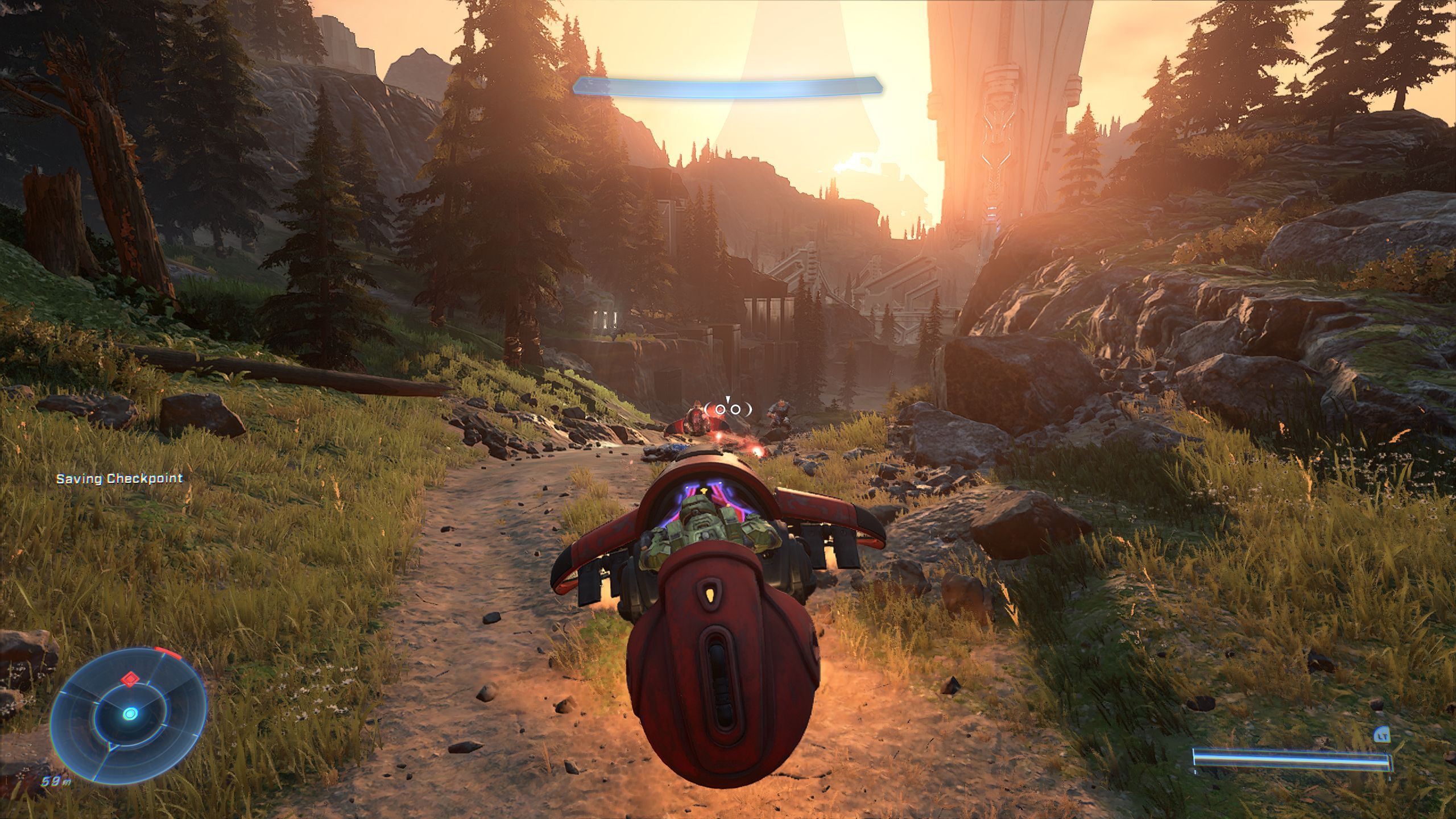
It’s slightly annoying to swap equipment anyway. It takes two presses of the D-pad for controller players. One arrow to open a submenu, then another to choose the equipment you want. It doesn’t sound like a big deal, but in the middle of a fight the awkwardness of moving your “get-me-outta-here” thumb to the equipment pocket becomes clear, as the Chief pauses mid-escape to navigate a drop-down menu.
Another feature of contention for Halo jocks are the boss fights. For me these have felt out of place since Tartarus first crumpled our heads with a hammer in Halo 2. I won’t spoil details, but in Infinite they are hit and miss, and come complete with conspicuous health bar. I understand, they’re here to add brutality and challenge to MC’s constant heroics. I just find them less interesting than when the more down-to-earth encounter design is done well. And it often is, even in random run-ins in hidden caves and other non-natural formations.
I understand, the boss fights are here to add brutality and challenge to MC’s constant heroics. I just find them less interesting than when the more down-to-earth encounter design is done well.
I’m talking camo Elites who attack in pairs, requiring frantic sensor deployment and close quarters scrambling. Or any fight with Hunters, the big blue boyfriends who scream and fume when you kill their mate (fun Halo lore: these guys are just loads of worms). Another time, I found myself shields-down in a small, enclosed hangar with a sword-wielding officer bearing down on me. I climbed into a Banshee just to get away from him, then crashed around inside the tiny space like a squealing pig in a bath tub, blasting at air and trying to run over my invisible foe based only on the sound of his furious yells. I enjoyed this organic, unpredictable fracas more than any of the boss fights.
There are engineered moments of combat beauty, too. There is a Banished tower called the House of Reckoning during the main quest, where the level designers got a bit sillier and built a series of funhouse battle rooms (they feel very inspired by the finale in Halo: Reach). As good looking as the neo-brutalist corridors of the Forerunner underground are, it’s the Banished prisons and big outdoor areas that offer the gun-toter a true runaround. On heroic or legendary difficulty settings, I already know some of these set pieces will be a fight-for-your-life nightmare.
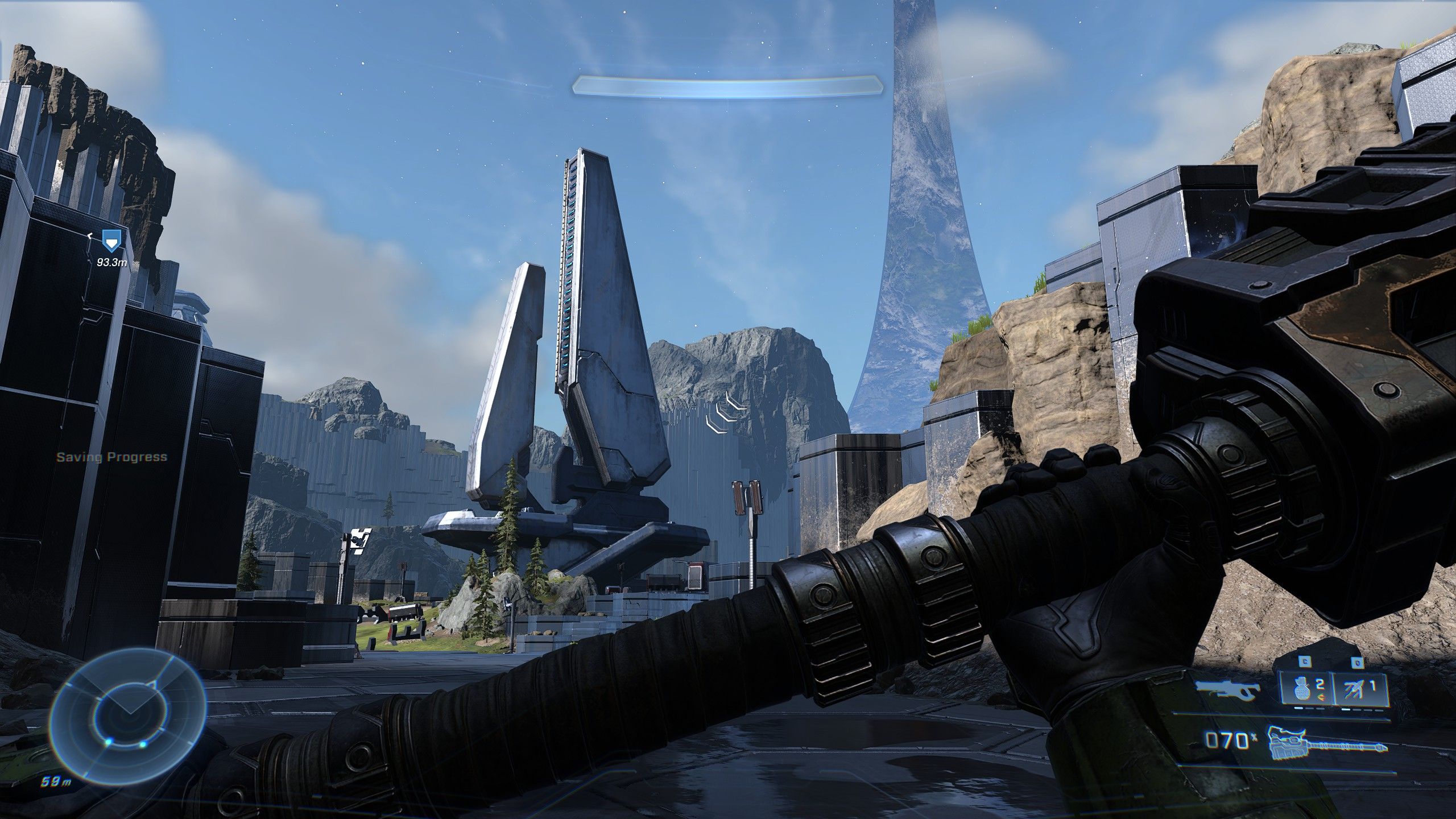
Don’t get me wrong, the innards of Forerunner levels contain some VERY decadent doors. But take my advice and slurp up all the open world mayhem and box-ticking before moving on to main missions, which will shunt you along a more traditional, linear path for longer than you might realise. (Don’t worry too much, though, you’ll get ample chance to mop up undone stuff).
Part of the cross-country pleasure comes from how nice it all looks. Not just the pine studded vistas but the characters too. From your apoplectic pilot pal to the mouth-breathing Brute boss of the Banished, the eyes and mouths of these characters are expressive to the point where it’s almost distracting. As if everyone on Zeta Halo is using their face to make up for the one stubborn supersoldier who doesn’t have one.
I make fun. As a story of human interest, it stomps in the right direction. Reducing the principal goodies to John Halo, his new holographic girlfriend, and the taxi driver who has to listen to them bickering, is a good move. But it remains overly concerned about your hardened killer. Continued attempts to humanise a faceless cypher are doomed to failure, and contrary to intention, the most interesting moment of his character in Infinite comes when Master Chief is at his most inhuman.
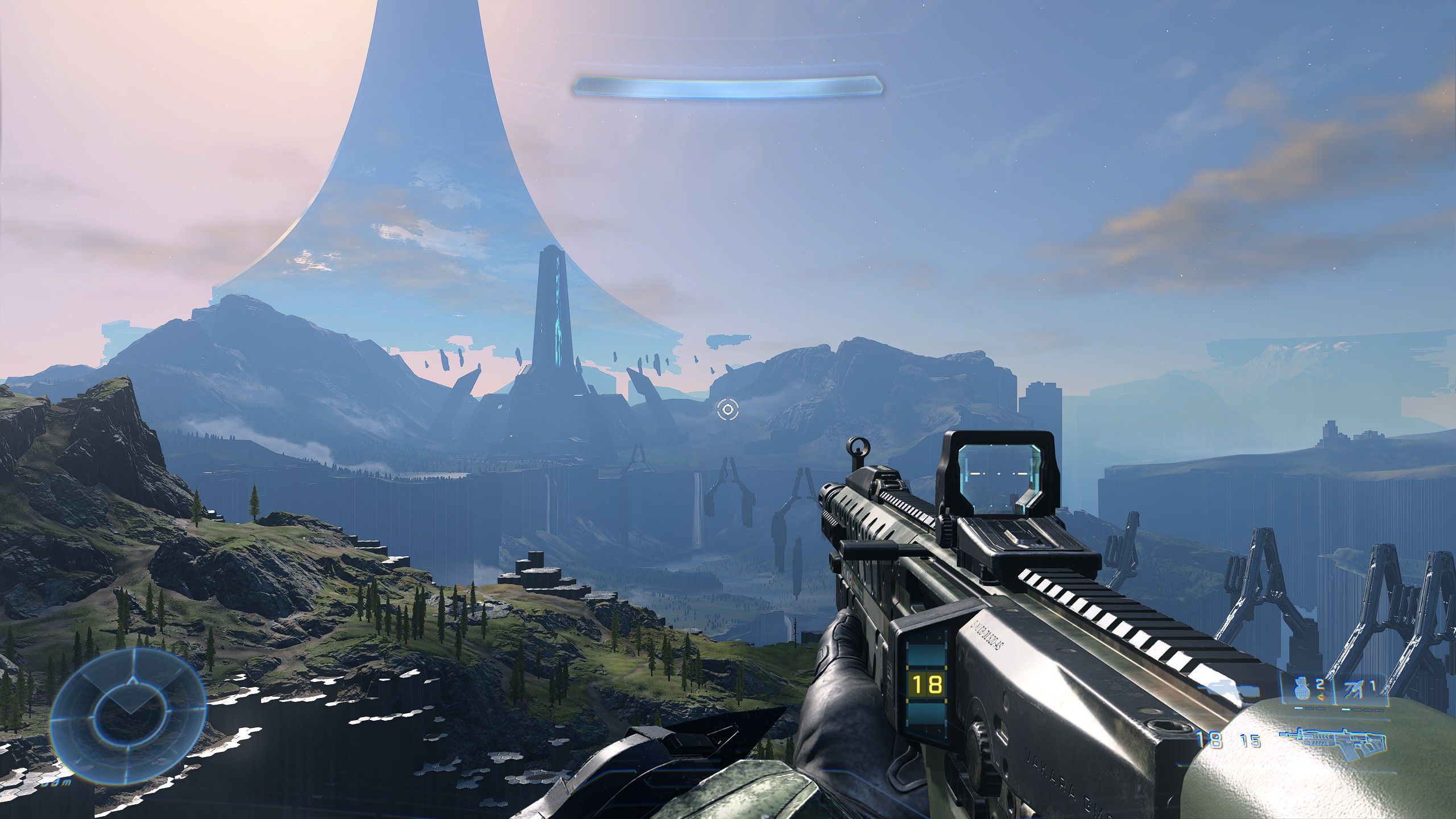
It’s the pilot, Echo 216, who has the most promise, being a character with a clean sheet and who is sick to the back teeth with the Chief’s heroic bullshit. In the end, his story takes a passenger seat to the relationship between flightless Iron Man and neo-Cortana. It’s a busy story, messily imparted through villainous monologues, AI epiphanies, and audio diaries. While the running and gunning hearkens back to those first gleeful road trips through canyons and river beds in Halo: Combat Evolved, the storytelling doesn’t mirror the action movie simplicity of that first game, and it suffers for having the baggage of five elaborate space operas and a “god bless our troops” tone it has not been allowed to sufficiently shake off.
Take the Banished as an example. They are a cult, obsessed with exterminating humanity and making their former leader proud. This too feels designed to evoke the fanaticism of the holy aliens we first encountered two decades ago. Which makes sense given the nostalgic feel this sequel is aiming for. Halo Infinite is a lot like Star Wars: The Force Awakens; it is built not to imitate its originator directly, but to rhyme with it in such a way that everyone can say, “Hey, this is old but also new”. As a result, Infinite’s story is still ankle-clamped by the overindulgence of its predecessors, even though it does what it can to shrink things down into a tighter, more coherent spacetale.
Even with these grumps about plot and characters, even with the sad lack of co-op or Forge mode at launch, this Halo ring is still a luscious national park devoted to rampage, Tarzan swings, hammer blows and big drums of plasma (my GOD these are fun to chuck). An open world Halo is something I didn’t even realise I wanted. I’m glad I got it. It has taken the series a while to look outside its corridor shooting monoculture for inspiration. But now that developers 343 Industries have broadened that corridor to the width of plains and stretched it to the height of mountains, it’ll be hard to go back. You can’t drive a jeep full of snipers down a corridor.
